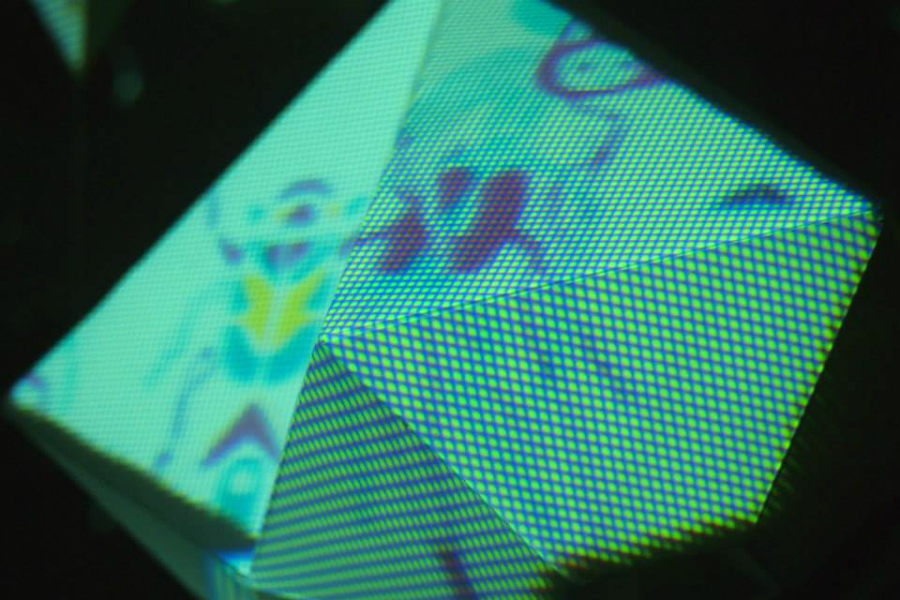Mountains and Valleys: Ana Cade

James Hampson considers a new illustration show at Arena Studios, and speaks to the artist behind it…
The Baltic Triangle is a pocket of town known for throwing up bits of bohemian artistry in unusual surrounds; this has never been truer than in the case of Mountains and Valleys, a new exhibition from artist Ana Cade. Her first solo show is tucked off in a corner of Arena Studios in the Elevator building, hidden away by the first floor lift.
It could easily be missed, but it would be a shame to do so.
It startles you when you first stumble across it. Sixty nine paper diamonds dangle from the ceiling, each cut from a single piece of paper (with the off-cuts scattered across the floor beneath). Thirty are printed with a series of illustrations, the rest are blank, only with the very same illustrations projected onto them, twinkling and ever-moving.
Themes of the new and old run through Cade’s work; a case in point being the soundscape from Deep Hedonia’s Sam Twidale, consisting of field recordings of rustling trees, bird calls, and dead leaves being crushed, all adding to the sense of finding nature in a place it’s least expected.
Cade, three years out of an illustration degree at John Moores University, having been “torn between that and fine art”, has been steadily making a name for herself in a series of collaborative works since then. She has carved out a niche for herself by mastering the art of screen printing, a traditional process used by very few today as their sole means of expression. She’s proud to carry a torch for this analogue method: “it allows you to transform the image and colours, and it’s a tricky process – hands on and difficult.”
With this installation Cade has ventured into the third dimension. “It’s because I’m obsessed with folding paper,” she says with a grin, “making strange formations and shapes, seeing what can be done.” She has focussed more and more on wet paper folding, an ancient Japanese technique which is closer to sculpting than origami, but just like origami, starts and ends with only one sheet of paper.
A strong Japanese influence runs through all of Cade’s work. The subject matter is resolutely (and equally) far flung, both in time and space. The images are closer to Aztec and Egyptian religious art, featuring curious animal/human hybrids engaging in strange rituals. “I chose those cultures because of their understanding of nature and rebirth,” explains Cade, and noting how it has become trite to use Christian imagery to make contemporary political statements in art, “we’ve distanced ourselves from what we prayed for and to.”
The use of paper feeds into Cade’s message regards natural processes and natural fibres, with shapes more reminiscent of those you find in nature than synthetic materials. Placing the flat-pack, unfolded version of every shape on the wall opposite the installations provokes thoughts about process and the cyclical nature of manufacturing any object.
As Cade says, “it would be hypocritical of me to say it’s about recycling. It’s not – it’s about the way we use things… it’s a way of demonstrating how everything comes from destruction… Environmental consideration becomes less of [an] issue to us as we distance ourselves from the effects of deforestation or habitation destruction.”
Everything in this neat piece has been thought through. The title, which at first might seem dreamy and twee, is practical in origin, as Cade explains “when you fold paper, it can be folded up into mountains or down into valleys.” A love for paper, and an obvious theoretical understanding of what it is, where it comes from and how it works, becomes ever more apparent as our conversation continues.
“What will be the consequences of our continual exploitation of natural resources?” asks the exhibition’s blurb. The location adds to the work’s statement about our indifference to environmental concerns. What could be better than a formerly derelict coffee warehouse?
With more shows on the horizon, an expanded range of materials (including wooden installations), and a greater role for the audience promised, we suspect she’ll get the audience both she and her message deserve. Cade is an artist with a bright future ahead of her, ironically, a future perhaps involving predictions of the dark one ahead of us.
James Hampson





